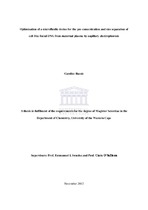| dc.contributor.advisor | Iwuoha, Emmanuel | |
| dc.contributor.advisor | O’Sullivan, Ciarra | |
| dc.contributor.author | Rassie, Candice | |
| dc.date.accessioned | 2015-10-19T14:41:54Z | |
| dc.date.available | 2015-10-19T14:41:54Z | |
| dc.date.issued | 2012 | |
| dc.identifier.uri | http://hdl.handle.net/11394/4589 | |
| dc.description | >Magister Scientiae - MSc | en_US |
| dc.description.abstract | The discovery of cell free foetal DNA (cffDNA) in 1997 allows for the combination of accuracy as well as non-invasiveness for prenatal diagnosis. This non-invasive genetic test requires only a maternal blood sample from which the cffDNA can be isolated and analysed. In this work cffDNA was isolated from a maternal blood sample using a micro-fluidic device which was fabricated using hot embossing and laser ablation techniques. The DNA sample was first pre-concentration by electrokinetic trapping (EKT) and then isotachophoresis (ITP). The concentrated sample was then separated by size using capillary electrophoresis (CE), all in a single device. All parameters and processes concerned with the micro-fluidic device were optimised sequentially. These parameters include both the chemical components as well as the physical processes which occur. The DNA used for the optimisation protocol was analysed using fluorescence spectroscopy, agarose gel electrophoresis as well as an Agilent Bioanalyser. The optimised protocol included a 9% acrylamide/pDMA matrix, 3 M N,N-dimethylurea as a denaturing agent, with tris based buffers for pre-concentration steps and 1X TBE (tris/borate/EDTA) buffer for capillary electrophoresis. The applied voltage of ITP was 300 V and CE was carried out at 180 V. The timing at which DNA was extracted from the device was kept at time = 60 s intervals. The optimised protocol was then used for real sample analysis and these samples were obtained from mothers pregnant with male foetuses. The DNA extracted from the micro-fluidic device was then analysed using real time PCR (RT-PCR) in order to distinguish which was maternal and which was foetal. This was carried out by amplification of male and general (present in male and female) genes respectively. RT-PCR results confirmed that only the male specific gene was amplified in initial samples exiting the device and it was thus successful in isolating cffDNA from a maternal plasma sample. | en_US |
| dc.language.iso | en | en_US |
| dc.publisher | University of the Western Cape | en_US |
| dc.subject | Prenatal diagnosis | en_US |
| dc.subject | Cell free foetal DNA | en_US |
| dc.subject | Microfabrication | en_US |
| dc.subject | Fluorescence spectroscopy | en_US |
| dc.subject | Microfluidics | en_US |
| dc.title | Optimisation of a microfluidic device for the pre-concentration and size separation of cell free foetal DNA from maternal plasma by capillary electrophoresis | en_US |
| dc.rights.holder | University of the Western Cape | en_US |

